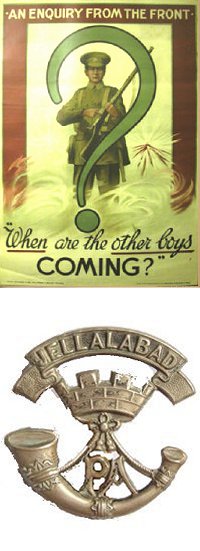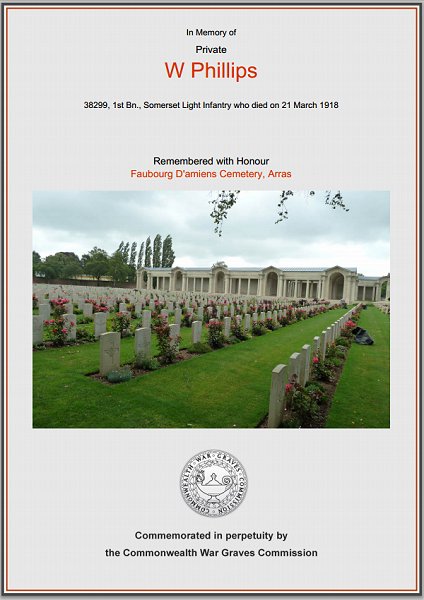yeovil at War
William Arthur Phillips
Died in France just days before the Armistice
William Arthur Phillips was born in Yeovil but I could find hardly any records for him at all. In the spring of 1915 a William Phillips married 49-year old Alma Reader at Yeovil, but whether or not it was 'the' William in question is not known. If he had been the same age as Alma he would have been too old to enlist, on the other hand he may have been ten years or more her junior and just managed to enlist at the upper age limit of 37. Sadly, that is all I could find out.
 Although
it known that
William enlisted
in the Regular
Army, in the 1st
Battalion,
Somerset Light
Infantry, at the
home barracks in
Taunton, it is
not known when.
However, from
his Service
Number 38299, it
was most likely
during 1916.
Although
it known that
William enlisted
in the Regular
Army, in the 1st
Battalion,
Somerset Light
Infantry, at the
home barracks in
Taunton, it is
not known when.
However, from
his Service
Number 38299, it
was most likely
during 1916.
In 1916 the 1st Battalion had moved south and were in action during the Battles of the Somme.
The Battle for the Somme has a unique place in British military history. Haig was in the middle of preparations for a British offensive but came under strong pressure to mount an attack due the French commitment to the Battle for Verdun, a city which held an important place in the nation's psyche and that the Germans had attacked in February 1916. Any Allied offensive would therefore have to be carried mainly by the British. Haig was therefore forced to undertake an offensive near to where the British and French lines met, near Bray-sur-Somme in Picardy, although he would have preferred to attack further north and to have had longer with which to prepare his new army. The battlefield was bisected by both the Albert – Bapaume Road and the River Somme, and was a series of gentle chalk ridge lines into which the Germans had dug a series of well-prepared fortifications. Haig's plan called for Rawlinson’s Fourth Army to achieve a breakthrough in the centre after which Gough’s Reserve Army (later renamed the Fifth Army) would exploit, roll up the German defences and capture Bapaume. Allenby's Third Army would undertake a diversionary attack on Gommecourt, which lay to the north. The massive preparatory bombardment, meant to destroy the German defences started on 24 June 1916 at 06.00. Over 1.7 million shells were fired but a high proportion, some 30 percent, failed to explode as the Ministry of Munitions had abandoned any semblance of quality control in order to be able to produce the quantities needed in time. Tunnelling companies dug hollowed out chambers underneath key German strongpoints and filled them with explosives. The shelling had started on 'U' Day and was meant to go on until 'Z' Day, which was 29 June 1916 but heavy rains caused the approach roads, trenches and crater ridden No-Man's land too muddy and so the assault was postponed until 1 July. Just after dawn on 1 July, the first British wave clambered out of their trenches and started to make their way towards the German frontline. As they did, seventeen enormous mines were detonated and the barrage moved forward. The infantry followed behind and although there were local gains on the first day, generally things looked bleak. The British suffered 57,470 casualties (19,240 killed and 2,152 missing) which was an unprecedented experience for the British Army. Seven 'New Army' divisions attacked, alongside three Territorial and four regular Army divisions. The French attack on the right of the British line was smaller than had been originally intended as troops had to be diverted to the fighting around Verdun but their attack went relatively successfully and the preponderance of heavy guns in the French sector also helped the British forces adjacent to them.
The British Army suffered, over the course of the entire 142-day campaign, some 415,000 casualties. The Somme campaign involved some twelve separate battles and finally came to an end on 18 November 1916.
In 1917 the 1st Battalion were at Arras, in action during the the First and Third Battles of the Scarpe, before heading north for the Third Battle of Ypres, where they fought in the Battle of Polygon Wood, the Battle of Broodseinde, the Battle of Poelcapelle and the First Battle of Passchendaele.
The Second Battle of Arras, fought between 9 April and 16 May 1917, was the British contribution to the Allied spring offensive of 1917. The original Allied plan for 1917, agreed at the Chantilly conference of November 1916, was for a second offensive on the Somme, but that plan was abandoned after a change of French leadership and it was decided that the British would attack around Arras and involve troops from three armies. In the north the Canadian corps of the First Army would attack Vimy Ridge. In the centre of the line the Third Army under General Allenby would attack from Arras. Finally, the British Fifth Army under General Gough would attack on the right of the line. The entire British attack was supported by 2,879 guns each of which had close to 1,000 shells. The British attack made impressive progress, but it did not achieve a breakthrough on the first day, allowing the Germans to rush their reinforcements into the gap and launch a series of counterattacks thereby slowing down the British attack. A renewed British attack at Bullecourt on 11 April failed to make any progress and the attack was suspended. The month of fighting around Arras cost the British 84,000 casualties and the Germans 75,000. Tactically it was a clear British victory, but the overall plan to cut off the German salient had failed.
Field Marshal Sir Douglas Haig thought that Flanders presented a much more attractive target than the Somme as it was close to the main British sources of supply, was familiar to his staff and offered the chance of a breakthrough with targets such as the German railhead at Roulers and the Channel ports from which German submarines were conducting operations (he was under pressure from the Admiralty to clear the Flanders coast). The attack was preceded by the assault of Plumer's Second Army on Messines on 7 June 1917 with the main attack coming on 31 July from Gough's Fifth Army - a little too late as it happens for the momentum had been lost in the interval. It consisted of three phases - the first being the battles for Pilckem Ridge, Gheluvelt Plateau and Langemarck where the Fifth Army pushed its way into a salient made all the more boggy by unseasonal weather and the shelling had badly damaged the land drainage system. Secondly, Second Army took over with the battles for Menin Road Ridge, Polygon Wood and Broodseinde, making good progress in the central sector. Finally, in the battles for Poelcappelle and Passchendaele the attackers, who were by this time exhausted, fought their way onto Passchendaele Ridge in appalling conditions, with the Canadians taking the village on 6 November 1917. The British lost well over 200,000 men, with the Germans losing a similar figure and the battle badly affected the morale of both sides, with the word 'Passchendaele' becoming a byword for suffering.
The Battle of Polygon Wood, 25-27 September 1917, was part of the wider Third Battle of Ypres. It came during the second phase of the battle, in which General Herbert Plumer’s Second Army was given the lead. Plumer replaced the ambitious general assaults that had begun the battle with a series of small attacks with limited objectives – his “bite and hold” plan. These attacks involved a long artillery bombardment followed by an attack on a narrow front (2,000 yards wide at Polygon Wood). The attacks were led by lines of skirmishers, followed by small infantry groups. German strong points were to be outflanked rather than assaulted. Each advance would stop after it had moved forward 1,000-1,500 yards. Preparations were then made to fight off any German counterattack. The attack on Polygon Wood was the second of Plumer’s “bite and hold” attacks, after Menin Road. It was carried out chiefly by the 4th and 5th Australian Divisions but the 1st Battalion, Somerset Light Infantry also played a part. The target was a line just beyond Polygon Wood (a wood in name only by 1917, having lost all of its trees in earlier fighting). The site of Polygon Wood was captured on 26 September, the target line on 27 September. The attack then stopped, and Plumer prepared for the next attack. The two Australian divisions lost 5,471 men during the Battle of Polygon Wood. The three “bite and hold” attacks brought the front line to the foot of the Passchendaele Ridge, which would be come the target of the First and Second Battles of Passchendaele, and give its name to the entire battle.
The Battle of Broodseinde, 4 October 1917, was the last of three successful “bite and hold” battles launched by General Herbert Plumer during the middle phase of the Third Battle of Ypres. Both sides were planning an attack on 4 October. When the British bombardment began, it caught a number of German units out in the open preparing for their own attack. The British attack contained divisions from Britain, New Zealand and Australia. As at Menin Road Ridge and Polygon Wood, the British attack achieved its main objectives and then halted to dig in. Although these attacks are normally described as small scale battles, the casualty figures demonstrate the real scale of the fighting. The Germans suffered 10,000 casualties and lost 5,000 prisoners. On the Allied side the Australians suffered 6,432 casualties, the New Zealanders 892 and the British 300.
In 1918 the 1st Battalion saw action on the Somme, then returned to Flanders fighting in the Defence of Hinges Ridge during the Battle of Hazebrouck and in the Battle of Bethune, the Advance in Flanders, the Battles of the Hindenburg Line and the Final Advance in Picardy.
Having been through so many battles, it would appear that William Phillips died from wounds received in the daily horrors of trench warfare on 21 March 1918. On 5 April 1918 the Western Gazette reported "Private W Phillips, of the Somerset Light Infantry, whose parents live at 19 Great Western Terrace, has died as a result of wounds received in action in France on the 22nd March. Much sympathy is felt for the bereaved parents."
William was interred at Faubourg D’Amiens Cemetery, Arras, Pas de Calais, France - Grave VII.B.10, and his name is recorded on the War Memorial in the Borough.
gallery

The Commonwealth War Graves Commission certificate in memory of William Phillips.

William Phillips' headstone.